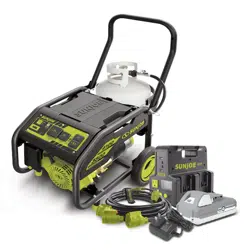Loading ...

2
9. Do not touch bare wire or receptacles.
10. Do not use generator with electrical cords which are worn,
frayed, bare, or otherwise damaged.
11. Do not operate or store the generator in rain, snow, or wet
weather.
12. Remove propane cylinder and restrain the unit from
moving before transporting in a vehicle.
13. Provide a plastic sheet or absorbent pad below
the generator to catch any drips of lubricant when
transporting.
14. Generators vibrate in normal use. During and after the
use of the generator, inspect the generator as well as
extension cords and power supply cords connected to
it for damage resulting from vibration. Have damaged
items repaired or replaced as necessary. Do not use plugs
or cords that show signs of damage such as broken or
cracked insulation or damaged blades.
15. For power outages, permanently installed stationary
generators are better suited for providing back-up
power to the home. Even a properly connected portable
generator can become overloaded. This may result in
overheating or stressing the generator components,
possibly leading to generator failure.
16. Use only recommended or equivalent replacement
parts and accessories and follow instructions in the
Maintenance section of this manual. Use of any other
parts or failure to follow maintenance instructions may
create a risk of shock or injury.
17. Maintain the unit per maintenance instructions in this
manual.
18. Inspect the unit before each use for loose fasteners, gas
leaks, etc. Replace damaged parts.
19. Always turn o gas at the propane cylinder when the
generator is not in use. Disconnect the cylinder before
storage.
20. Before storing, allow the engine to cool for 30 minutes
and remove propane cylinder from the unit. Do not store a
propane cylinder attached to or near the generator. If not
followed exactly, a re causing death or serious injury may
occur.
21. Inspect the propane connection hose for damage before
each use. If it is evident there is excessive abrasion or
wear, or the hose is cut, it must be replaced prior to the
generator being put into operation. The replacement hose
assembly shall be that specied by the manufacturer.
22. Only use a propane cylinder that includes a collar to
protect the cylinder valve.
23. If a leak is detected at any time, get away from the
propane cylinder and call the re department.
24. Do not use the generator until leak-tested as described in
the manual.
25. Propane cylinders must be stored outdoors out of reach of
children and must not be stored in a building, garage, or
any other closed in area.
Additional Safety Instruction
for Propane Generator
mDANGER! Never disconnect the propane cylinder when
unit is running. Shut o engine and allow the unit to cool at
least ve minutes.
mWARNING! When this generator is used to supply
a building wiring system: generator must be installed by a
qualied electrician and connected to a transfer switch as
a separately derived system in accordance with NFPA 70,
National Electrical Code. The generator shall be connected
through a transfer switch that switches all conductors other
than the equipment grounding conductor. The frame of the
generator shall be connected to an approved grounding
electrode. Failure to isolate the generator from power utility
can result in death or injury to electric utility workers.
• Do not use this generator to provide power for emergency
medical equipment or life support devices.
• This generator has a neutral oating condition. This means
the neutral conductor is not electrically connected to the
frame of the machine.
• Operate in a well-ventilated, well-lit area isolated from
working areas to avoid noise interference.
• Operating the generator in wet conditions could result in
electrocution. Keep the unit dry.
• Keep the generator a minimum of 3 feet away from all types
of combustible material.
• Do not operate generator near hazardous material.
• Do not operate generator at a gas or natural gas lling
station.
• Do not touch the muer or cylinder during or immediately
after use; they are HOT and will cause burn injury.
• Do not remove the oil dipstick when the engine is running.
• Pay close attention to all safety labels located on the
generator.
• Keep children a minimum of 10 feet away from the
generator at all times.
• The unit operates best in temperatures between 23°F and
104°F with a relative humidity of 90% or less.
• Operating voltage and frequency requirement of all
electronic equipment should be checked prior to plugging
them into this generator. Damage may result if the
equipment is not designed to operate within a +/- 10%
voltage variation, and +/- 3 hz frequency variation from the
generator name plate ratings. To avoid damage, always
have an additional load plugged into the generator if solid
state equipment (such as a television set) is used. A power
line conditioner is recommended for some solid state
applications.
Loading ...
Loading ...
Loading ...
